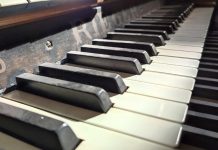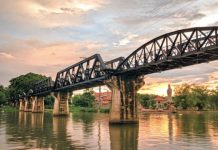With the launching recently, at the Ocean Marina on the shore of the Pattaya-Jomtien littoral, of the “First Solar-assisted Luxury Catamaran in the World”, named the Heliotrope, Thailand takes the lead in the burgeoning boat-building, cruising and leisure industry, world-wide.
This beautiful catamaran has been built with the most advanced technology in marine engineering, focusing on solar-powered energy for mobility, as well as operating the state-of-the art facilities on board.
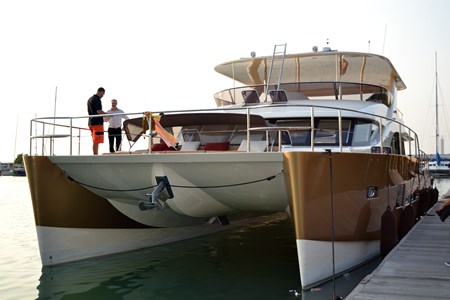 The Heliotrope, a 20-meter (65-ft.) luxury, solar-assisted catamaran by shipyard Bakri Cono.
The Heliotrope, a 20-meter (65-ft.) luxury, solar-assisted catamaran by shipyard Bakri Cono.
The craft features a specially-created golden-coloured hull, to accentuate the sun’s dominance in all the operations and the interior is decorated in traditional Asian style, enhanced by local artisans concentrating on minute attention to detail. This ambience features exotic local materials, including precious woods and gold leaf. To board the craft is to enter a five-star establishment – and one which can travel the world.
The Heliotrope is a model of a panacea for environmental destruction – if only a minor one – in a world of over-used fossil fuels and their derivatives which are rapidly destroying our habitats.
A great awakening
I awoke one morning, in September, 1991, at the ripe young age of 55, to an urgent request to proceed to the Ocean Marina in Jomtien, to witness nautical history.
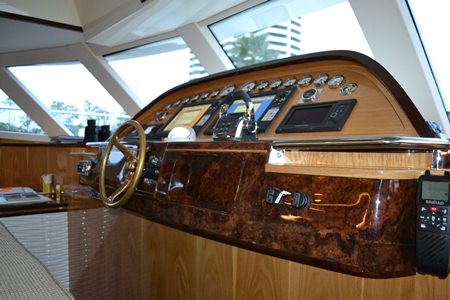 The vessel uses state of the art technology to form a landmark in boat-building design.
The vessel uses state of the art technology to form a landmark in boat-building design.
There, representing the Bangkok Post, I was a privileged observer to the launching of the (then) “largest yacht in the world”. Totally built in Thailand, by the Concorde Yacht Company – established for this purpose – the yacht was designed by naval architect Bruce Farr and built by Finnish expert Pekka Koskakyla.
The magnificent Mirabella 40 had a real Thai launching, towed to the Ocean Marina water-front, by two Thai nationals – two pachyderms. As this period preceded the Internet and the subsequent information explosion, the elephants were a welcome addition, for I was able to use the then-extant trunk line, to file my story!
This remarkable 40-meter (approx. 130 ft.) sleek craft, incorporated one of the newest applications of fibre-glass moulding, with a hull surface of some 450 square meters, requiring 4000 liters of epoxy and 2,000 liters of other materials, all Thai-made products. But all the rest of the huge inventory required of a sailing craft, was imported into the Kingdom at an enormous cost. At launching, the yacht had racked up a price tag of some $US 7 million. The Mirabella weighed 150 tons and was propelled by 1,000sq. m. of sail, with auxiliary power of two 500-hp twin diesel engines.
Back to the future
Some two decades later, in early 2014, I awoke (yet, again), this time to a call from the Bakri Cono Shipyard at the Ocean Marina, to come to Jomtien, to cover the launching of the world’s first solar-assisted luxury catamaran, named the Heliotrope – another nautical history.
Well, since I saw the Mirabella and, this time, when I saw the Heliotrope, so much had changed in a world totally in the grip of technology. After my own “Rip Van Winkle” hiatus (for the uninformed, Rip V.W. was a 19th century creation of American author Washington Irving who slept away two decades and awoke to a totally-changed world), I was facing a totally a new environment. In the quarter century of my own somnambulism, I seem to have missed so much. Unfortunately, I did not by-pass my “mid-life crisis”. Nevertheless, it came – and, fortunately – went!
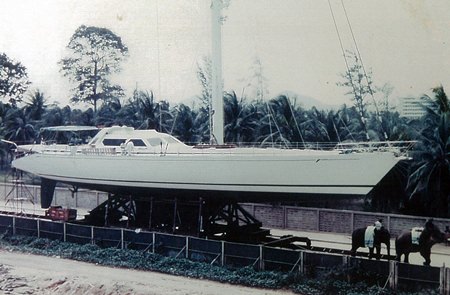 This 1991 photo shows the Mirabella 40 being towed to its launch point at Ocean Marina by two elephants, pictured bottom right.
This 1991 photo shows the Mirabella 40 being towed to its launch point at Ocean Marina by two elephants, pictured bottom right.
Now, back to the future and the arrival of the Heliotrope, a 20-meter (65-ft.) luxury, solar-assisted catamaran. The craft is absolutely breathtaking, both internally and outside. Rather than be towed into the sea by elephants, like the Mirabella, this imposing craft met the sea that day via a traditional Thai blessing, bestowed by a Buddhist monk.
I was most fortunate at this launching to be in the company of world-renowned Anglo-Italian writer, photo-journalist and broadcaster, James Nicholls, whose vast nautical portfolio runs to yachting events at successive Olympic Games, Volvo Ocean Races and America’s Cups. Much of the technical information produced herewith, is courtesy of James who ran a two-page feature of the event, in the Pattaya Mail recently.
As James noted in his introduction, “The amount of attention to detail and clever thinking that has gone into the creation of the Heliotrope is immense. The craft represents an enormous leap into the future while, although powered by two marine diesels, all the ancillary power is channeled by solar energy, producing seven kilowatts, the solar panels providing 220 volts. Excess energy is stored in the batteries.”
Why Heliotrope?
Or should that read, what’s in a name? Plenty, as far as this craft is concerned. Heliotrope is taken from a Latin word heliotropium, transcribed from Greek and used towards the end of the 14th Century meaning, roughly, Turning towards the Sun. Rather an apt name, one would think, for a new craft which derives its mobility and maintenance mainly from solar panels absorbing the Sun’s energy. Closer to everyday reality, the sunflower is a recognizable image of this concept.
A cast of hundreds
One of the many members of the advisory board established to create the Heliotrope was American astronaut Michael Lopez-Alegria. As James Nicholls remarked at the Ocean Marina splendid launching party, “Michael easily relates to the technology behind the craft for, as an astronaut, he has been much closer to the Sun than any of us earth-bound mortals!”
The development of the Heliotrope featured a cast of hundreds, which includes many able artisans at the Bakri Cono shipyard. Probably the leader of the pack is Swiss national Philippe Guenat, an international yachtsman of some repute, Chairman of Bakri Cono’s Technical Advisory Board and President of the Hoteliers Commission of Thailand.
Raphael Domjan (there we go, another Swiss national, showing that the Swiss not only make superb time-pieces but are in the forefront of innovative technology), is regarded by his peers as one of the world’s foremost experts on the harnessing of solar power.
Among the select group which attended the official launch was Pattaya Mayor Ittipol Kumplone and his team of city fathers who have fostered marine and water sports around Pattaya and its environs. City Hall views such activities as being most conducive to promoting Pattaya and the Eastern Seaboard as a water sports haven.
The Mayor himself has always regarded the splendid waterways along the Eastern Seaboard as a most positive contribution to the city-by-the sea. He was visibly impressed with the advent of the Heliotrope and considers it as yet another manifestation of the viability of Pattaya.
He pointed out, with more than a touch of pride, that the total concept of the new craft was incredible evidence that Thailand, through Pattaya, has moved rapidly into the burgeoning marine technology industry. He emphasized that ALL the intricate equipment and technology required for such a sophisticated craft, had been produced in the Kingdom.
This makes a good comparison to the Mirabella, built some two decades ago, where all fittings, rigging and the endless paraphernalia incumbent on outfitting a yacht were, by necessity, imported at considerable cost.
Mutual interests converge
Undoubtedly, the driving force behind the huge operation to create the Heliotrope has been – and will continue to be – the personable, tall and extremely presentable young South African, Bernard Lamprecht, who now manages the Bakri Cono shipyard, founded in 1994 by his father Corrie.
At the outset, Bernard realized that there was a market for luxury catamaran solar-assisted power boats and the new shipyard was the place to start, an idea readily supported by renowned Ukrainian naval architect Albert Nazarov, already involved in Jomtien-based boat building.
But the fickle hand of destiny had other ideas: one fateful day Bernard met a dynamic European lady – now the proud owner of the Heliotrope. The lady was looking for a shipyard which could build a luxury catamaran in accordance with her demanding specifications, especially an environmentally-friendly craft. Bernie was looking for a client – and Voila! it all came together. The brain-child of this liaison was the superb Heliotrope.
Even before all this, the precedent was already there. Raphael Domjan (noted above), founder of the Swiss Foundation for Sustainability and regarded as the world’s foremost proponent of solar power, directed a prototype solar-energy craft named Turanor Planet Solar, virtually a floating solar panel, which in early 2000 completed a circumnavigation of the world using only solar power.
Whither or, wither Chakri Cono?
But, far from a “Whithering” Chakri Cono, on the contrary it is on the cusp of a tremendous surge: “Wither”, rather, indicates a blue-print for a huge step forward for Thailand and Pattaya’s marine industry and, by implication, great development in marine solar-energy applications. Every sector will benefit: Thailand’s marine infrastructure and the work-force servicing it, the marine industry as a whole, the marine leisure and related industries, all of us addicted to marine and water sports, and the environment.
Orders for several craft are now in the pipeline, including a monstrous Heliotrope 105 (approx. 40 ft.) which is already on the drawing board. To accommodate these orders Bernard is planning to re-locate the shipyard to a much larger facility and will expand the staff to some 150, from the current 54. This increase alone reflects the Chakri Cono philosophy of customization and fulfilling a customer’s ideas and desires, within the feasibility of the craft’s construction.
To ensure these ends, Bakri Cono has established close liaison with the electronic departments of Thai universities, to create a steady pool of newly-qualified science graduates to join the company.
As for me, I look forward to some outings on a Bakri Cono solar-powered catamaran in the near future, but in the meantime I shall stay with my four-metre sail-powered OK dinghy. My solar panels will be strictly “landlubbers”, attached to my brain.


